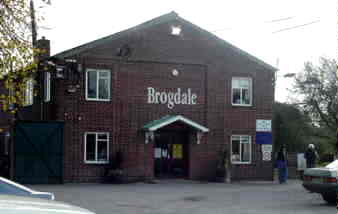
Apples in the National Fruit Collection at Brogdale

I was recently shown around part of the National Fruit Collection by its Curator, Dr. Emma-Jane Lamont. It's located just outside Faversham, Kent, (Brogdale Rd, Faversham) and is a remarkable collection of apples, pears, plums and other fruit. There are, for example, over 2,000 varieties of apple: two trees of each kind, laid out on an enormous grid system. It's on a similar scale to the magnificent fruit gardens of Versailles, but meticulously organised. I wanted to find samples of the apples Annie Elizabeth and Allens Everlasting, because I'd had some trouble identifying them. No problem - Annie Elizabeth is row 45, tree 93, and Allens Everlasting is row 31, tree 57 - both were found within a few minutes.
The collection is effectively an enormous filing cabinet of genetic material - the country's 2,000 or so best apples. They are not grown organically. The main purpose of the collection is to preserve the varieties, and this means that anything which endangers a tree (e.g. pests or disease) has to be dealt with in the quickest and most effective way. This usually means spraying. Each day a person walks up and down the rows, noting which trees may need attention.
We were given samples of a few varieties to test for vitamin C content (see elsewhere on these apple pages) and then Emma-Jane took us to the library, which was packed with filing cabinets and thousands of files containing information on fruit trials, information about each type, photographs, slides and digital pictures assembled over the lifetime of the collection - which was started in the early 1800s but which was greatly expanded in the fifties and afterwards by the Ministry of Agriculture at its new Brogdale site.
As well as Dessert and Culinary, the apple collection includes other things: crab apples, cider apples, rootstocks, and some un-named varieties judged worthy of keeping. I was interested to see trees of MM106, M26, M9 and M27 rootstocks, all with their own apple crop. These stocks, familiar to fruit grafters, produce yellow apples; MM106 are large, and decent cookers in their own right; the smaller stocks (M26 downwards) produce what look like old-fashioned cider apples: small, yellow and slightly flattened, with a rather bland taste and, when ripe, a woolly texture.
Click on the text below to see pictures of these apples.
I didn't photograph M9 or M27 because they looked exactly the same as M26.
The Fruit Collection is owned by Brogdale Horticultural Trust and is well worth a visit; if you're a fruit enthusiast it's a terrific day out. They sell trees, fruit, related books, and show visitors around the collection; the guides are knowledgeable and interesting. There's also a tea room. The web address for Brogdale is
Nigel Deacon / Diversity website